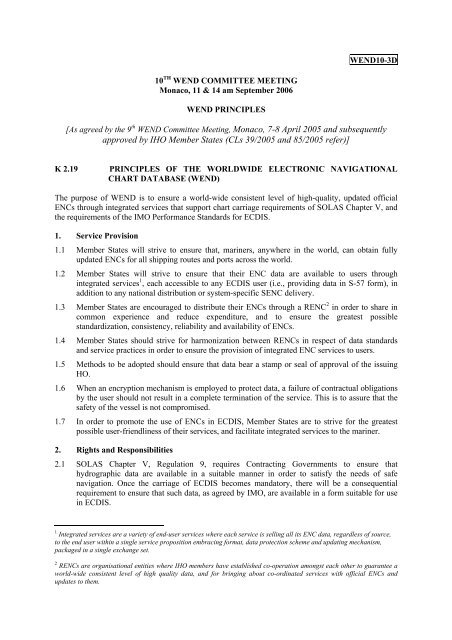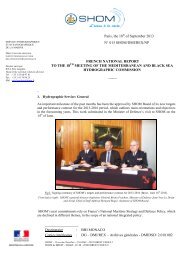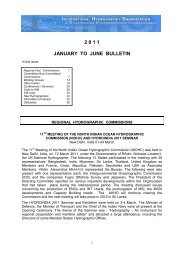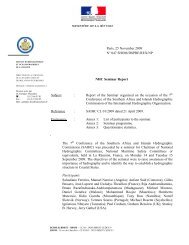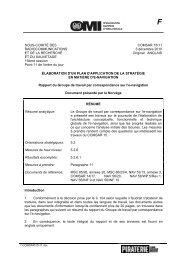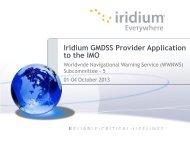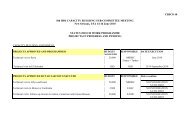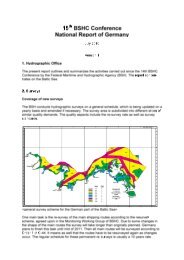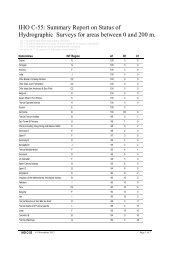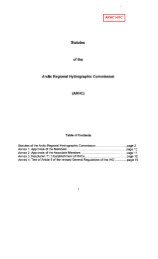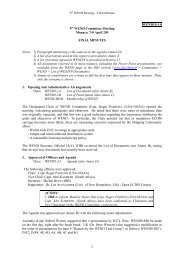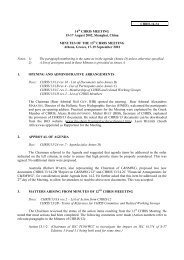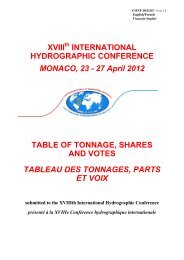WEND10-3D - IHO
WEND10-3D - IHO
WEND10-3D - IHO
You also want an ePaper? Increase the reach of your titles
YUMPU automatically turns print PDFs into web optimized ePapers that Google loves.
<strong>WEND10</strong>-<strong>3D</strong><br />
10 TH WEND COMMITTEE MEETING<br />
Monaco, 11 & 14 am September 2006<br />
WEND PRINCIPLES<br />
[As agreed by the 9 th WEND Committee Meeting, Monaco, 7-8 April 2005 and subsequently<br />
approved by <strong>IHO</strong> Member States (CLs 39/2005 and 85/2005 refer)]<br />
K 2.19<br />
PRINCIPLES OF THE WORLDWIDE ELECTRONIC NAVIGATIONAL<br />
CHART DATABASE (WEND)<br />
The purpose of WEND is to ensure a world-wide consistent level of high-quality, updated official<br />
ENCs through integrated services that support chart carriage requirements of SOLAS Chapter V, and<br />
the requirements of the IMO Performance Standards for ECDIS.<br />
1. Service Provision<br />
1.1 Member States will strive to ensure that, mariners, anywhere in the world, can obtain fully<br />
updated ENCs for all shipping routes and ports across the world.<br />
1.2 Member States will strive to ensure that their ENC data are available to users through<br />
integrated services 1 , each accessible to any ECDIS user (i.e., providing data in S-57 form), in<br />
addition to any national distribution or system-specific SENC delivery.<br />
1.3 Member States are encouraged to distribute their ENCs through a RENC 2 in order to share in<br />
common experience and reduce expenditure, and to ensure the greatest possible<br />
standardization, consistency, reliability and availability of ENCs.<br />
1.4 Member States should strive for harmonization between RENCs in respect of data standards<br />
and service practices in order to ensure the provision of integrated ENC services to users.<br />
1.5 Methods to be adopted should ensure that data bear a stamp or seal of approval of the issuing<br />
HO.<br />
1.6 When an encryption mechanism is employed to protect data, a failure of contractual obligations<br />
by the user should not result in a complete termination of the service. This is to assure that the<br />
safety of the vessel is not compromised.<br />
1.7 In order to promote the use of ENCs in ECDIS, Member States are to strive for the greatest<br />
possible user-friendliness of their services, and facilitate integrated services to the mariner.<br />
2. Rights and Responsibilities<br />
2.1 SOLAS Chapter V, Regulation 9, requires Contracting Governments to ensure that<br />
hydrographic data are available in a suitable manner in order to satisfy the needs of safe<br />
navigation. Once the carriage of ECDIS becomes mandatory, there will be a consequential<br />
requirement to ensure that such data, as agreed by IMO, are available in a form suitable for use<br />
in ECDIS.<br />
1 Integrated services are a variety of end-user services where each service is selling all its ENC data, regardless of source,<br />
to the end user within a single service proposition embracing format, data protection scheme and updating mechanism,<br />
packaged in a single exchange set.<br />
2 RENCs are organisational entities where <strong>IHO</strong> members have established co-operation amongst each other to guarantee a<br />
world-wide consistent level of high quality data, and for bringing about co-ordinated services with official ENCs and<br />
updates to them.
2.2 It is expected that Member States, for waters of national jurisdiction, will have mature supply<br />
systems for ENCs and their subsequent updating in place by the earliest date for mandatory<br />
carriage of ECDIS.<br />
2.3 By the dates established by IMO 3 , Member States will strive to either:<br />
a Provide the necessary ENC coverage, or<br />
b Agree with other States to produce the necessary ENC coverage on their behalf.<br />
<strong>IHO</strong> will address overall coverage on a regional basis through Regional Hydrographic<br />
Commissions.<br />
2.4 The INT chart system is a useful basis for initial area selection for producing ENCs.<br />
2.5 Member States are encouraged to work together on data capture and data management.<br />
2.6 Responsibilities for providing digital data outside areas of national jurisdictions must be<br />
established (see guidance in Annex).<br />
2.7 Technically and economically effective solutions for updating are to be established conforming<br />
to the relevant <strong>IHO</strong> standards. The updating of ENCs should be at least as frequent as that<br />
provided by the nation for correction of paper charting.<br />
2.8 The Member State responsible for originating the data is also responsible for its validation in<br />
terms of content, conformance to standards and consistency across cell boundaries.<br />
2.9 A Member State responsible for any subsequent integration of a country’s data into a wider<br />
service is responsible for validating the results of that integration.<br />
2.10 National HOs providing source data are responsible for advising the issuing HO of update<br />
information in a timely manner.<br />
2.11 Member States should work together to ensure data integrity, and to safeguard national<br />
copyright in ENC data to protect the mariner from falsified products, and to ensure traceability.<br />
2.12 In producing ENCs, Member States are to take due account of the rights of the owners of<br />
source data and if paper chart coverage has been published by another Member State, the rights<br />
of that State.<br />
2.13 Member States should recognize their potential exposure to legal liability for ENCs.<br />
3. Standards and Quality Management<br />
3.1 A Quality Management System should be considered to assure high quality of ENC services.<br />
When implemented, this should be certified by a relevant body as conforming to a suitable<br />
recognised standard; typically this will be ISO 9001:2000.<br />
3.2 There must be conformance with all relevant <strong>IHO</strong> and IMO standards.<br />
4. Assistance and Training<br />
4.1 Member States’ HOs are strongly recommended to provide, upon request, training and advice<br />
to HOs that require it to develop their own national ENC provision.<br />
3 The IMO Sub-Committee on Safety of Navigation, at its 51th Session (NAV 51):<br />
• agreed to recommend to the IMO Marine Safety Committee the mandatory carriage requirement of ECDIS<br />
for High Speed Craft (HSC) by 1 July 2008.<br />
• did not decide on a mandatory carriage requirement for other types of ship; this will be considered in<br />
conjunction with a Formal Safety Assessment (FSA) to be conducted into the use of ECDIS in ships other than<br />
HSC and large passenger ships.”
Annex to K2.19<br />
Guidance for the Establishment of ENC Production Boundaries<br />
a<br />
b<br />
c<br />
d<br />
e<br />
f<br />
g<br />
h<br />
i<br />
ENC duplication should be avoided. A single ENC producing country should exist in any<br />
given area.<br />
A country is normally the ENC producing country for waters within its national jurisdiction.<br />
Responsibility for the production of ENC can be delegated in whole or in part by a country to<br />
another country, which then becomes the producing country in the considered area.<br />
When the limits of waters of national jurisdiction between two neighbouring countries are not<br />
established, or it is more convenient to establish boundaries other than established national<br />
boundaries, producing countries are to define the boundaries for ENC production within a<br />
technical arrangement. These limits would be for cartographic convenience only and shall<br />
not be construed as having any significance or status regarding political or other jurisdictional<br />
boundaries.<br />
In international waters, the INT chart producer nation shall be assumed to be the producer of<br />
the corresponding ENC. Where the offshore limits of waters under national jurisdiction have<br />
not yet been established, clause ‘d’ should apply.<br />
In areas where the paper INT charts overlap, neighbouring producer nations should agree a<br />
common limit of ENC production in the overlapping areas. Cartographic boundaries should<br />
be as simple as possible; for example: a succession of straight segments and turning points<br />
corresponding to such things as meridians, parallels, or chart limits. Where different producer<br />
nations are responsible for INT coverage of the same area at different scales, those nations<br />
should agree on a suitable set of boundaries so as to provide the user with the most coherent<br />
service possible.<br />
In areas of national jurisdiction for which there is no recognised ENC producer nation, the<br />
Regional Hydrographic Commission (or similar body) should determine the ENC producer<br />
nation. ENCs produced under such arrangements should be offered for transfer to the<br />
Coastal State in the event that the Coastal State subsequently develops the capacity to<br />
maintain the ENCs. Such transfer should respect the moral rights of the Coastal State and the<br />
commercial rights of the producer nation.<br />
When the production limits are the official limits for national jurisdiction waters, commercial<br />
rights shall belong to the ENC producing country.<br />
When the production limits are cartographic boundaries as opposed to national boundaries,<br />
the commercial rights shall normally belong to the ENC producing country but may possibly<br />
be encumbered by the payment of royalties to the relevant country through a technical<br />
arrangement (see clause d).


